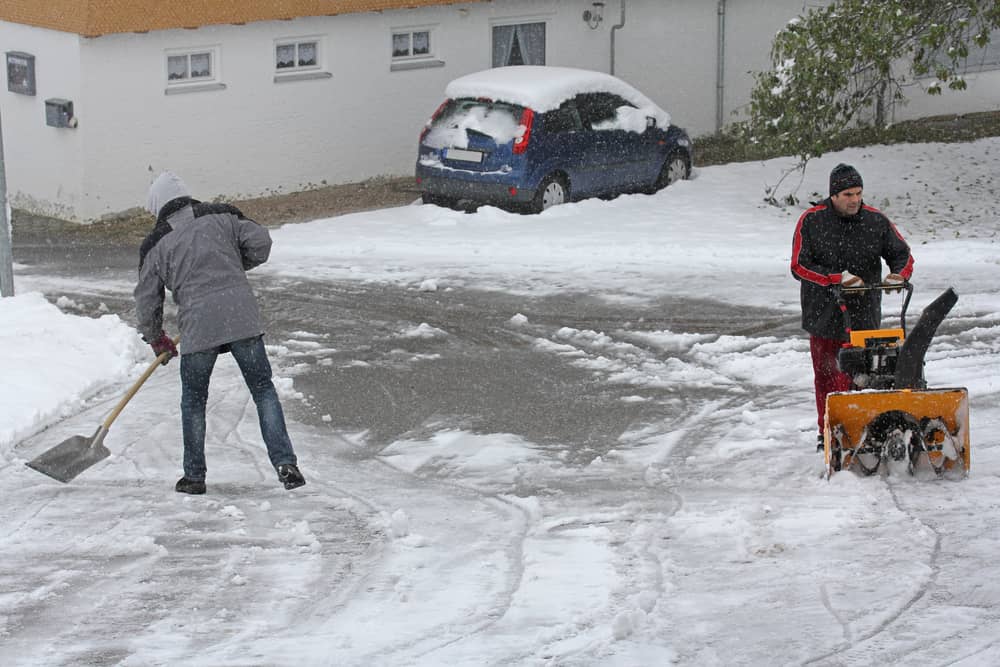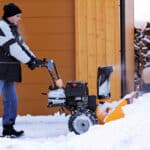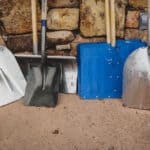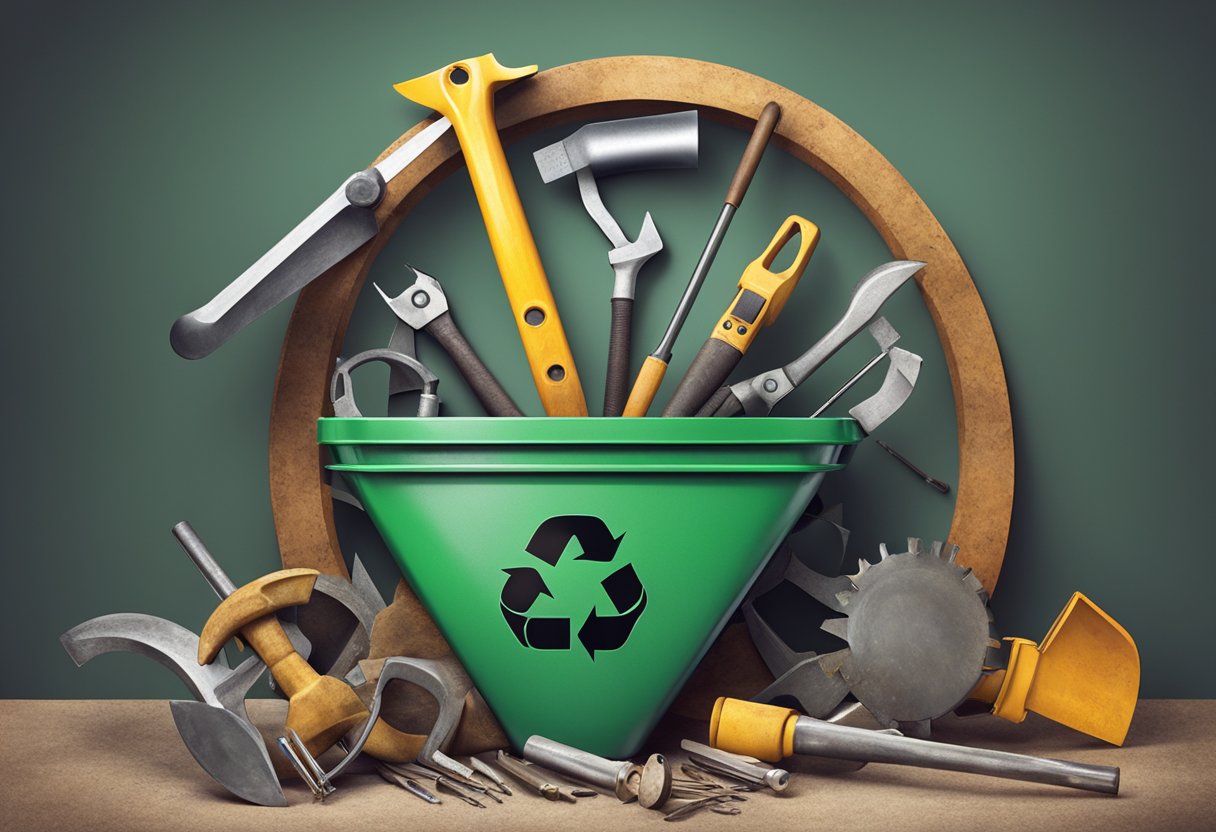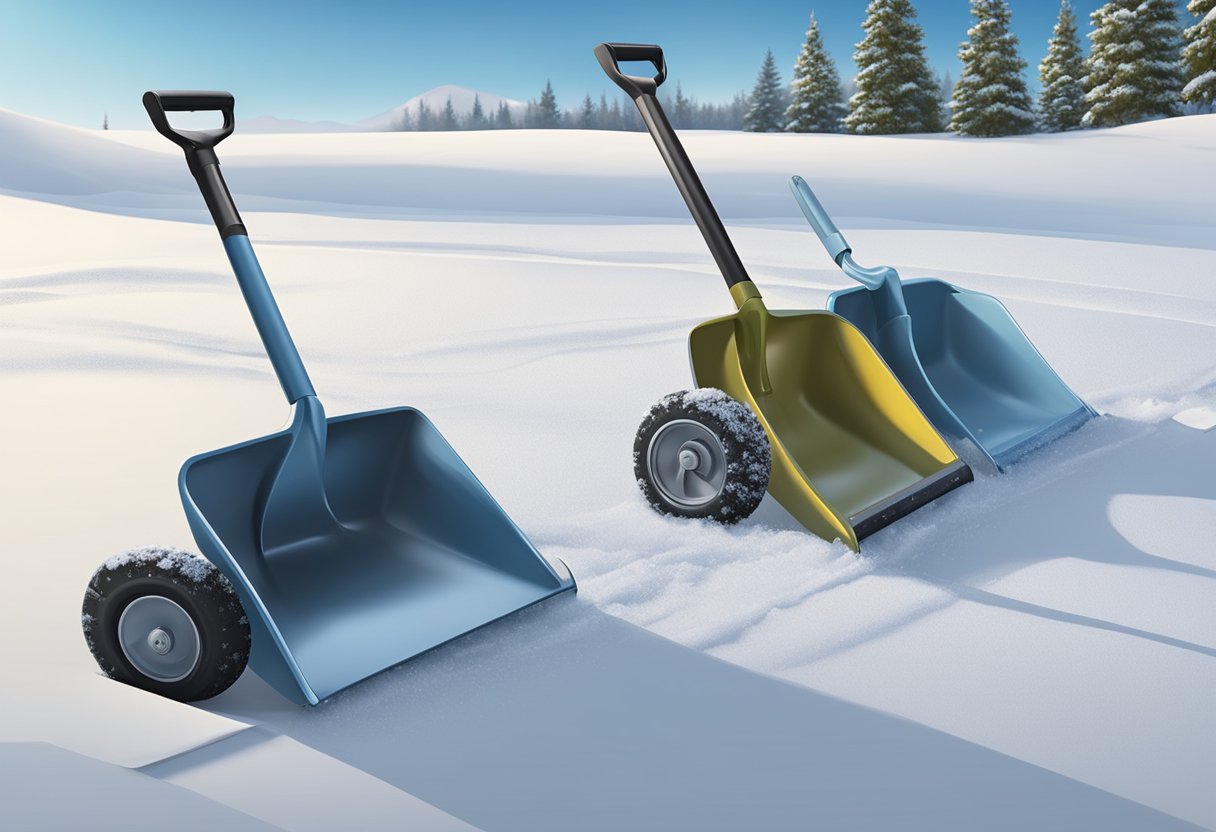Did you know that the term “snowblower” is a misnomer?
These machines push snow through them instead of blowing it out using air.
Unfortunately, some believe snowblowers are a pain to use, but the alternatives of either manually moving snow with a shovel or simply ignoring it will get you nowhere.
Table of Contents
What is a Snowblower?
A snow blower is designed to help you remove snow from a specific area, usually a driveway or a sidewalk.
The blower works by using an auger to move the snow through the machine and propel it off to the side, effectively clearing the space you need.
While they are not helpful for areas with little to no snowfall, anyone who has had to break out a snow shovel understands how much work goes into moving snow and how beneficial a snowblower would be.
Types of Snowblowers – Single-stage, Two-stage, Three-Stage
Different types of snow blowers are equipped to handle different situations, specific hazards and have cost considerations.
When you go to purchase a snowblower, you will find that the blower will fit into one of the following categories:
- Single-stage
- Two-stage
- Three-stage
The single-stage, two-stage, and three-stage categories will help identify the blower’s unique abilities and features to help you quickly narrow down your purchasing choice.
Single Stage Blower Features
Single-stage blowers use a high-speed auger to scrape snow off the ground and propel it into the snowblower’s discharge chute.
A single-stage blower is not usually self-propelled, so it is harder to use on a steep incline.
While they are certainly more effective than a shovel and a bit of willpower, single-stage blowers are best used to tackle light situations, such as:
- Shallow snow depth; up to four inches
- Freshly plowed or fallen snow that has yet to freeze
- “Clean” snow that is free of debris
Two-Stage Blower Features
Snowblowers with more power are usually two-stage blowers.
These have an auger resembling a corkscrew and slowly turns to gather snow, moving it to the housing center.
From there, an impeller blows the snow into the air, clearing a wider path.
Unlike single-stage snowblowers, two-stage snow blowers tend to be self-propelled and have multiple speeds.
A two-stage blower is larger and heavier than a single-stage blower; it is self-propelled and has various speeds.
Therefore, it would be difficult to manually push a two-stage blower along, especially in cold weather conditions, but it would be beneficial to clear an incline.
While two-stage snowblowers can tackle the workload of a single-stage snowblower and then some, they are not necessary unless you have:
- A larger area to cover
- Heavier snowfall
- A steeper grade
- Gravel or debris
- If you get heavy snowfall regularly, every other day.
Three Stage Blower Features
Three-stage snow blowers are nowhere near as standard as two-stage snowblowers, but they do exist.
They generally feature a slow-turning auger, and a three-stage snowblower removes heavy snow almost 20 percent faster than a two-stage snowblower of the same size.
Three-stage blowers are the ones brought in when snowfall reaches a depth of more than two feet.
They are also great at chopping through thicker snow and even ice and would be useful if you have:
- A very large area to cover
- If you get wet or very deep and heavy snowfall regularly
Snowblower Power Sources – Gas, Electricity, Battery
Each source of power a snowblower utilizes will get the job done, however a gas powered snowblower is the most powerful of all the power sources but they do all have pros and cons.
Gas Pros and Cons
Snowblowers powered by gasoline can be any of the three stages, but two-stage and three-stage will always be gas.
Any commercial-grade snowblowers are likely gas-powered to ensure proper strength when dealing with demanding jobs.
Gas-powered snow blowers are more powerful than other fuel types, and they can be easier to perform maintenance on without needing to go to a professional if you have skills in this area.
These heavier machines are more difficult to maneuver, and they do require regular maintenance.
Having to rush to your local gas station may also prove to be an issue, especially when you are faced with a situation and need your snowblower, so plan and ensure you have the gas required and remember to store your gas safely.
Good luck getting on the road when your driveway is snowed in.
Electric Pros and Cons
If you do not need much power, you should consider an electric snowblower.
These are corded machines that work well for most homeowners.
They start quickly and are friendlier to the environment.
In addition, electric snowblowers require less maintenance than their gas-powered cousins, making them more economical and better for anyone who is not mechanically inclined.
They are also lighter in weight and easier to move around.
This ease all comes at a cost.
Corded snowblowers require a cold weather extension cord and access to an outlet.
If the power grid fails or you are in the middle of a blackout, then you are out of luck.
Corded snowblowers are also less powerful than gas blowers and therefore limited to patios, walkways, smaller driveways, and lighter snowfall.
Battery Pros and Cons
Battery-powered snow blowers, also known as cordless snowblowers, are comparable to electric motors, but you can freely move around and are not tethered to an outlet.
Instead, they are a lightweight and portable option for tackling lighter snow.
They do fall into the same issues as their corded counterparts.
Battery-powered blowers are less powerful, so you should only count on them for light snowfall or smaller areas.
However, it would be best to keep the batteries charged, and failing to do so puts you in a tough spot when you need them.
Depth of Snow
The different blower types and fuels have various pros and cons, so no one size fits all situations, and they are equipped to handle different snow loads.
If your snowfall depth is less than 12 inches, then a single-stage blower would have no problem, regardless of its fuel type.
The difference in performance would be speed, and gas would likely win.
After that first foot of snow, you should stick to two-stage or higher snowblowers.
The single-stage blowers struggle to process deeper snowfall, and you run the risk of damaging your blower, injuring yourself, and washing your time.
After two feet of snowfall, you should stick to a three-stage snowblower or wait it out.
The three-stage blower is the strongest of the three, and it can handle over 20 inches of wet, heavy snow or even two feet of slush.
Potential Hazards
Despite their many benefits, there are common hazards to watch out for when operating your snowblower, the most prevalent being:
- Projectiles
- Auger pulling in clothing
- Burns
- Carbon Monoxide
- Traumatic hand and finger amputation
Regardless of the conditions outside, keeping children and pets in the home is a good practice while operating a snowblower.
There are too many opportunities for error or injury for them to roam around unaware.
Projectiles
If a snowblower picks something up, then you should expect it to come out the other side.
For the most part, this should be snow, but things like rocks and sticks are ejected at dangerous speeds.
These projectiles will break windows easily, but they can also strike a child, neighbor, you, or other property.
So pay attention to the direction your chute is aimed.
Auger Pulling in Clothing
Unfortunately, snowblower augers are known to pull in any loose clothing they come in contact with.
The apparel most likely to cause problems to include:
- Scarves
- Jackets
- Pants
- Shoelaces
- Long hair
Do your best to wear clothing that keeps you warm and is not loose or baggy, and pay attention to what comes close to that auger.
Burns
Burns are less common with single-stage mowers that have hidden mufflers.
However, two-stage mowers have exposed mufflers that are a burn hazard, even with additional guards.
Please pay attention to your body while operating a snowblower; it can be easy to lose track of the heat of the machine when dealing with the cold.
Carbon Monoxide
You should never start a gas-powered blower inside, even if you have an electric start system.
It is too easy for carbon monoxide to build up before you get the chance to step outside.
Carbon Monoxide is not a problem for electric-powered snowblowers, both corded and cordless.
Traumatic Hand and Finger Amputations
Snowblowers happen to be the leading cause of traumatic hand and finger amputations, and a lot of these instances come from an individual trying to unjam the auger manually.
If you need to unjam your auger, you should always ensure the motor has been completely turned off, and you are on a flat surface.
Try to unblock it using an object such as a long stick, not your hand.
The auger can return to its normal state instantly, turning quickly, possibly injuring any body parts in its vicinity.
Standard Parts of a Snowblower
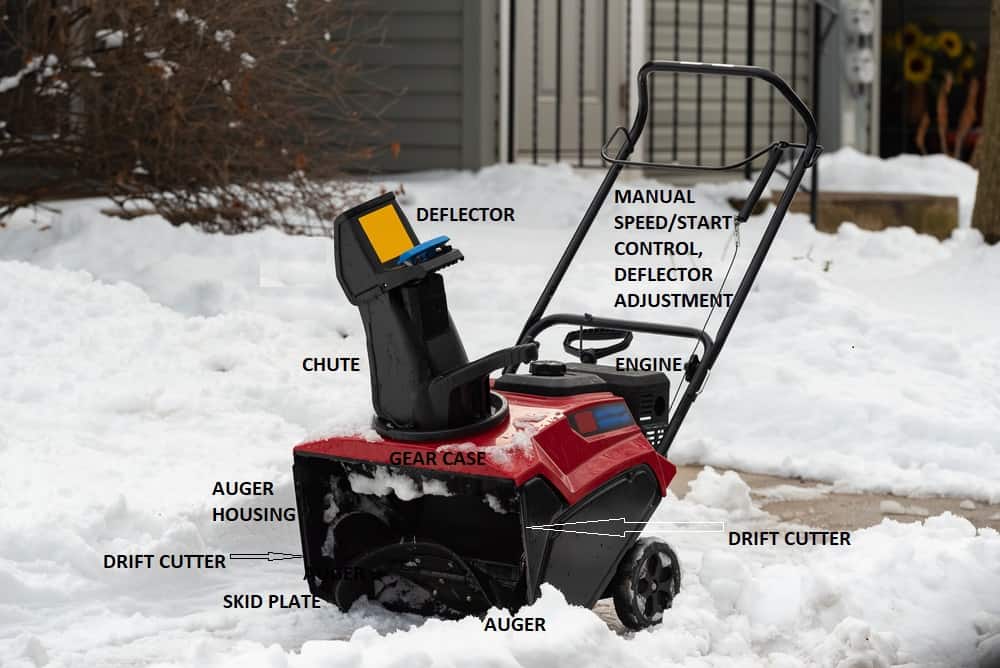
Snowblowers are not deeply intricate machines, but they have a fair share of unique parts.
- Auger: moves snow through the blower
- Auger Housing: the structure at the front of the machines where snow is collected and processed
- Chute: the piece extending from the auger housing that discharges the snow
- Deflector: an adjustable extension at the top of the chute; directs the angle the snow “blow” out at
- Drift Cutters: bars installed on both sides of the auger housing to cut through high drifts and effectively direct snow to the augers
- Engine: the part that powers the snowblower
- Gear Case: houses gears that rotate the auger shaft
- Impeller: a spinning mechanism that resembles a fan and discharges snow from the chute; behind augers
- Joystick Controls: the operator’s tools used to control the parts of the snowblower, including the chute, deflector, and auger
- Lights: provide light in times there is none or little; for example, at night
- Scraper Blade: bottom of auger housing that scrapes the surface of the left behind snow
- Shear Pins/Bolts: designed to break when auger casing is being over-torqued
- Skid Shoes: metal or polymer skits that attach to each side of the auger and prevent damage
These are the standard parts of a snowblower, but you can also purchase additional accessories like caps and snowblower covers.
Snowblower Cost
The average cost sits around $400, but the price fluctuates depending on your needs. The cost and function required are essential to do proper research before settling on a snowblower.
Consider the following to help with your decision:
- Your average snowfall
- The presence of debris in your snow
- The area you need to work on
These factors tend to be the same for similar locations, and they influence what fuel and stage you need to look for in a snowblower.
Cost Depending on Location
If you live where snow is expected but not heavy, you can get away with a cheaper snowblower.
These usually sit at $400 to $600, but you can find certain corded and cordless varieties at a lower price.
In the U.S.A., places where snow is expected but not heavy are most common in the lower northeast, parts of the pacific northwest, and Northern California.
In Canada, snow is expected, but not heavy, is most common in provinces with mid to heavy snowfalls, including Saskatchewan, Alberta, Ontario, and Manitoba, where 40 to 200 cm of snowfall annually, or 15 inches to 87 inches.
The mildest locations in Canada have also been known to receive the white stuff occasionally, and the coastal areas of B.C. may receive 0 cm to 40 cm or 0 inches to 15 inches annually.
Remember that even these areas can get hit by harsher weather like those in the midwest, New England, and the mountainous west.
In that case, you need a heavier duty snowblower, usually two-stage or three-stage.
In that situation, you can settle for one at $400 to $600, but you will get more benefits by spending more.
Cost Depending on Fuel Type
As a general rule, you should expect gas machines to be more expensive than their electric counterparts.
Gas snowblowers tend to cost about 20 percent more than the others, but they are also larger and more powerful.
Electric snowblowers, both corded and cordless, will cost less than their gas-powered counterparts.
They are great for light work or needing to buy one in a pinch, but you are not saving, financially speaking, if you buy an electric snowblower when you need a gas-powered one.
Cost Depending on Stage
As the design of a single-stage snowblower is for lighter work, expect them to cost less.
The single-stage is also the only stage encompassing electric snowblowers, and we already know that those tend to be cheaper.
Two and three-stage blowers are generally limited to gas, so they cost more right off the bat.
These are larger, more powerful machines, and they also require more upkeep.
So even if you find a great deal on one, expect to keep putting money into it to keep it running.
Upkeep is not a bad thing, but it is something that you should consider.
Are Snowblowers Worth It?
Well, unless you live somewhere where it never snows, snowblowers are a worthwhile investment.
They limit the amount of time and effort you need to spend to clear pathways to navigate your yard and roadways safely, keep your home and other structures on your property safe, and that sense of security is priceless.
Taking the time to research specific snowblowers and ensure they meet your needs properly will go a long way.
I know from experience that nothing is worse than investing in a tool only to discover it will not get the job done.
People who think that snowblowers are a waste of money maybe purchased one without proper research or probably were not realistic with their situation and their snow blower’s capabilities.
When in doubt, buy one that can handle more.
You never know when the extra features will come in handy.
Are you wondering what snowblower to get? In our guide How to Find The Right Snowblower For You, we drill down further into the best type for location and suggest a few purchasing choices for your consideration.

